1961 brought a new front end with free-standing headlights on short stalks in the front fenders a style used in the 1930’s Chryslers favored by Exner. He maintained the look of the modern and largest tailfins ever. Interior highlights were an improved dash layout featuring a straight rectangular bank of gauges. The pillared 4-door sedan was dropped and returned in 1967 model year. Due to the styling bizarre and poor quality control, sales dropped to 12,258.
The 1962 tailfins were elongated and streamlined topped with free-standing gun-sight taillights. The front grille was split and a giant round Eagle hood ornament was fitted for the first time. The years designs had a slim TorqueFlite A727 automatic transmission that would allow smaller transmission “hump” in the floor. It provided comfort for middle front seat-passengers. Only convertibles had dual standard exhaust. The Imperial’s dedicated production plant was closed this year returning to the Jefferson Avenue factory in Detroit as Chryslers since sales were not enough to maintain it a separate brand.
1963, the taillights were inside the rear fenders, the grille split was dropped and again replaced with a cluster of chromed rectangles. The roofs of the Custom and Crown were redesigned to be more -square and with thicker c pillars for the two and four-door sedans. Elwood began to do his touches on the Imperials especially the base and roofs. Chrysler hired Engel from Ford, where he had built the 1961 Lincoln Continental. Engel’s design skills led to the drop of Exner’s fins and featured a familiar three-box design and a more rectilinear designing. At first sight, the whole styling of the Imperials resembled Engel’s previous Lincoln Continental of 1961. The two cars shared clean slab-sided body panels, C-pillars and chrome molding outline at the top of the fender line. Engel applied subtle curves and parallelogram angles on the Imperial as a distinctive feature.
